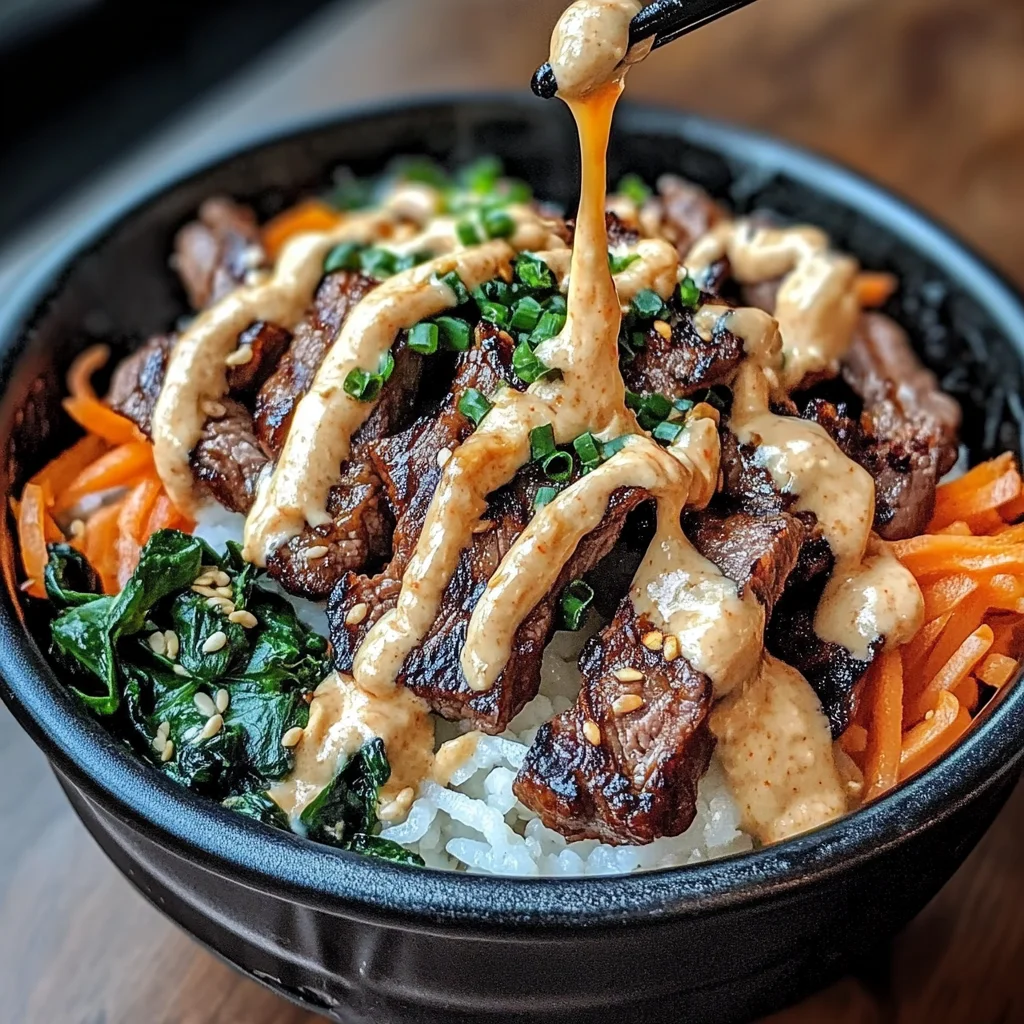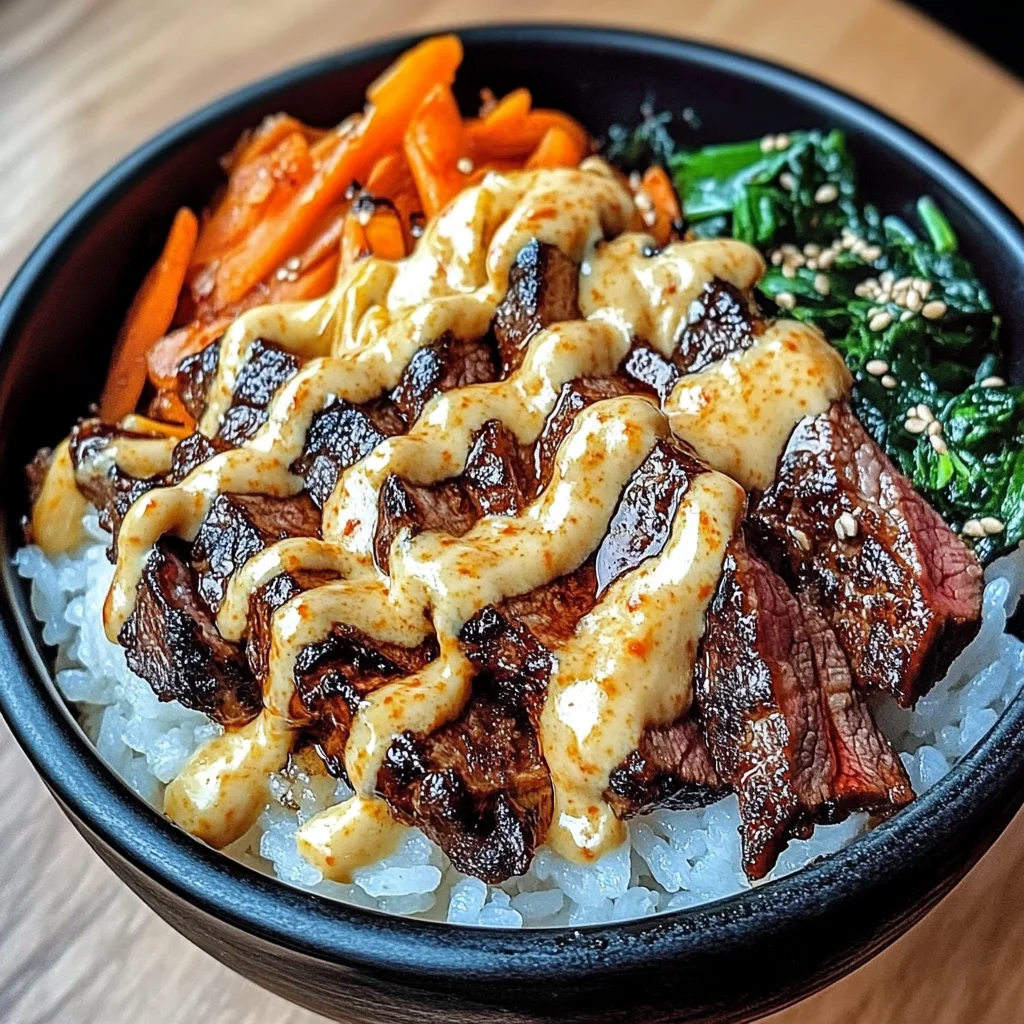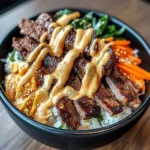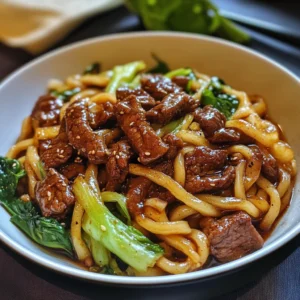Korean Beef Bibimbap with Gochujang Aioli is a delightful dish that brings vibrant flavors and colors to your table. Perfect for family dinners or casual get-togethers, this recipe combines flavorful grilled beef with fresh vegetables, all topped with a spicy and creamy gochujang aioli. The balance of textures and tastes makes this bibimbap not only delicious but also visually appealing, ensuring it’s a hit on any occasion.

Jump to:
- Why You’ll Love This Recipe
- Tools and Preparation
- Essential Tools and Equipment
- Importance of Each Tool
- Ingredients
- For the Bibimbap:
- For the Gochujang Aioli:
- How to Make Korean Beef Bibimbap With Gochujang Aioli
- Step 1: Grill the Beef
- Step 2: Make the Gochujang Aioli
- Step 3: Assemble the Bibimbap
- Tips:
- How to Serve Korean Beef Bibimbap With Gochujang Aioli
- Bowl Presentation
- Garnish with Sesame Seeds
- Serve with Fresh Herbs
- Accompany with Pickled Vegetables
- Provide Extra Gochujang Aioli
- How to Perfect Korean Beef Bibimbap With Gochujang Aioli
- Best Side Dishes for Korean Beef Bibimbap With Gochujang Aioli
- Common Mistakes to Avoid
- Storage & Reheating Instructions
- Refrigerator Storage
- Freezing Korean Beef Bibimbap With Gochujang Aioli
- Reheating Korean Beef Bibimbap With Gochujang Aioli
- Frequently Asked Questions
- Can I use different meats in Korean Beef Bibimbap With Gochujang Aioli?
- How spicy is Gochujang?
- Can I prepare this dish ahead of time?
- What kind of rice should I use?
- Is there a vegetarian version of this recipe?
- Final Thoughts
- 📖 Recipe Card
Why You’ll Love This Recipe
- Quick to Prepare: This recipe comes together in under 30 minutes, making it perfect for busy weeknights.
- Flavor Explosion: The combination of grilled beef and gochujang aioli creates a bold and savory flavor that will tantalize your taste buds.
- Customizable: Feel free to swap out the vegetables or proteins to suit your preferences or what you have on hand.
- Healthy Ingredients: Packed with fresh veggies and lean protein, this dish is not only tasty but nutritious too.
- One-Bowl Wonder: All the components are served in one bowl, making it easy to eat and perfect for meal prep.
Tools and Preparation
To make Korean Beef Bibimbap with Gochujang Aioli, you’ll need some essential kitchen tools. Having the right equipment can make the cooking process smoother and more enjoyable.
Essential Tools and Equipment
- Grill
- Mixing bowls
- Whisk
- Knife
- Cutting board
Importance of Each Tool
- Grill: Ideal for achieving that smoky flavor on the beef while keeping it juicy.
- Mixing bowls: Perfect for combining ingredients without making a mess.
- Whisk: Ensures a smooth consistency for your gochujang aioli.
- Knife & Cutting board: Essential for chopping vegetables quickly and safely.

Ingredients
For the Bibimbap:
- 1 pound boneless, skinless beef, cut into bite-sized pieces
- 1 tablespoon olive oil
- 1 teaspoon garlic powder
- 1/2 teaspoon onion powder
- 1/4 teaspoon salt
- 1/8 teaspoon black pepper
- 1 cup cooked rice
- 1 cup chopped spinach
- 1/2 cup chopped carrots
- 1/4 cup chopped red onion
- 1/4 cup chopped green onions
For the Gochujang Aioli:
- 1/4 cup mayonnaise
- 1 tablespoon gochujang (Korean chili paste)
- 1 teaspoon soy sauce
- 1/4 teaspoon garlic powder
- 1/8 teaspoon sesame oil
How to Make Korean Beef Bibimbap With Gochujang Aioli
Step 1: Grill the Beef
Preheat the grill to medium-high heat. Season the beef with garlic powder, onion powder, salt, and pepper. Grill the beef for 2-3 minutes per side, or until cooked through.
Step 2: Make the Gochujang Aioli
In a small bowl, whisk together mayonnaise, gochujang, soy sauce, garlic powder, and sesame oil until well combined.
Step 3: Assemble the Bibimbap
Divide the cooked rice among bowls. Top each bowl with grilled beef, chopped spinach, carrots, red onion, and green onions. Drizzle generously with the prepared Gochujang Aioli before serving.
Tips:
You can use any type of beef you like for this recipe. For a spicier aioli, add more gochujang. Serve the bibimbap with your favorite side dishes, such as kimchi or kimchi jjigae.
How to Serve Korean Beef Bibimbap With Gochujang Aioli
Korean Beef Bibimbap with Gochujang Aioli is a vibrant dish that can be enjoyed in many ways. Whether you’re hosting a dinner or looking for a delightful meal for yourself, here are some serving suggestions to elevate your experience.
Bowl Presentation
- Use colorful bowls to serve the bibimbap, showcasing the vibrant ingredients like spinach, carrots, and beef. This adds visual appeal and makes each serving feel special.
Garnish with Sesame Seeds
- Sprinkle toasted sesame seeds on top before serving. This adds a nutty flavor and a nice crunch that complements the other textures in the dish.
Serve with Fresh Herbs
- Add fresh herbs such as cilantro or parsley on top. These herbs enhance the flavors and add a refreshing element to each bite.
Accompany with Pickled Vegetables
- Include pickled vegetables like daikon or cucumber on the side. Their tanginess balances the richness of the bibimbap and adds an extra layer of flavor.
Provide Extra Gochujang Aioli
- Serve additional Gochujang Aioli on the side for those who like it spicier. This way, guests can customize their bibimbap to their taste preferences.
How to Perfect Korean Beef Bibimbap With Gochujang Aioli
To ensure your Korean Beef Bibimbap with Gochujang Aioli turns out perfectly every time, keep these tips in mind.
- Choose Quality Beef: Select tender cuts of beef such as sirloin or flank steak for optimal flavor and texture.
- Prep Ingredients Ahead: Chop vegetables and prepare rice beforehand to save time during assembly.
- Adjust Spice Level: For those who enjoy heat, increase the amount of gochujang in the aioli or add more chili flakes.
- Use Day-Old Rice: Stale rice works best for bibimbap as it holds its shape better and doesn’t become mushy when cooked.
- Warm Your Bowls: Preheat your serving bowls in warm water before plating to keep your dish hot longer.
- Layer Flavors: Start with rice at the bottom, then layer beef and veggies on top for an attractive presentation that showcases each ingredient.
Best Side Dishes for Korean Beef Bibimbap With Gochujang Aioli
Pairing side dishes with Korean Beef Bibimbap enhances your meal experience. Here are some excellent options:
- Kimchi: This fermented vegetable dish adds a spicy kick and probiotics that are great for digestion.
- Korean Potato Salad: A creamy salad made with potatoes, carrots, and mayonnaise offers a comforting contrast to the bibimbap’s textures.
- Seaweed Salad: Light and refreshing, this salad provides a crispy texture that complements the main dish beautifully.
- Spicy Cucumber Salad: Made with cucumbers tossed in a spicy vinegar dressing, this salad offers a cool crunch alongside your bibimbap.
- Zucchini Noodles: Lightly sautéed zucchini noodles can be served as a low-carb alternative that pairs well with the flavors of bibimbap.
- Miso Soup: A warm bowl of miso soup rounds out the meal with umami flavors and is perfect for sipping between bites of bibimbap.
- Steamed Broccoli: Simple yet nutritious, steamed broccoli adds color and health benefits without overpowering other flavors.
- Rice Cakes (Tteok): Chewy rice cakes provide unique texture and can be enjoyed plain or lightly seasoned as a delightful side option.
Common Mistakes to Avoid
When making Korean Beef Bibimbap With Gochujang Aioli, be aware of common pitfalls that can affect the dish’s flavor and presentation.
- Ignoring the seasoning: Properly seasoning the beef enhances its flavor. Don’t skip marinating or adding spices; this step is crucial for a tasty result.
- Overcooking the beef: Cooking the beef too long can make it tough. Aim for a quick grill time of 2-3 minutes per side to keep it tender and juicy.
- Using stale ingredients: Fresh vegetables are key to great bibimbap. Check your produce for freshness before using, as wilted veggies can ruin the dish.
- Neglecting the aioli ratio: The right balance of gochujang and mayo is essential. Taste as you go to ensure your aioli has the perfect kick without overpowering other flavors.
- Forgetting presentation: Bibimbap is visually appealing when layered nicely. Take time to arrange ingredients in bowls for a beautiful meal that’s just as pleasing to look at as it is to eat.

Storage & Reheating Instructions
Refrigerator Storage
- Store leftovers in airtight containers.
- Consume within 3-4 days for best quality.
Freezing Korean Beef Bibimbap With Gochujang Aioli
- Place bibimbap in freezer-safe containers or bags.
- Best enjoyed within 1-2 months of freezing.
Reheating Korean Beef Bibimbap With Gochujang Aioli
- Oven: Preheat oven to 350°F (175°C). Cover with foil and heat for about 15-20 minutes until warmed through.
- Microwave: Place in a microwave-safe bowl, cover, and heat for 2-3 minutes, stirring halfway through for even heating.
- Stovetop: Heat in a skillet over medium heat. Stir occasionally until heated through, about 5-7 minutes.
Frequently Asked Questions
Here are some common questions people have about making Korean Beef Bibimbap With Gochujang Aioli.
Can I use different meats in Korean Beef Bibimbap With Gochujang Aioli?
Yes! You can substitute chicken, turkey, or lamb if you prefer. Just adjust cooking times accordingly based on the meat used.
How spicy is Gochujang?
Gochujang has a moderate spice level. For those who prefer less heat, you can reduce the amount used in the aioli.
Can I prepare this dish ahead of time?
Absolutely! You can pre-cook the beef and veggies, then assemble just before serving. The aioli can also be made ahead and stored in the fridge.
What kind of rice should I use?
Short-grain rice is traditional for bibimbap due to its sticky texture. However, you can also use jasmine or brown rice based on your preference.
Is there a vegetarian version of this recipe?
Yes! You can replace beef with tofu or tempeh and use vegetable broth instead of meat-based options for an excellent vegetarian bibimbap.
Final Thoughts
Korean Beef Bibimbap With Gochujang Aioli is a delightful dish that combines bold flavors and vibrant colors. Its versatility allows you to customize it according to your taste preferences by swapping proteins or adding more vegetables. Give this recipe a try; it’s sure to impress!
Did You Enjoy Making This Recipe? Please rate this recipe with ⭐⭐⭐⭐⭐ or leave a comment.
📖 Recipe Card
Print
Korean Beef Bibimbap with Gochujang Aioli
- Total Time: 25 minutes
- Yield: Serves 4
Description
Korean Beef Bibimbap with Gochujang Aioli is a vibrant and flavorful dish that brings the essence of Korean cuisine to your kitchen. This one-bowl meal features tender, grilled beef paired with a colorful array of fresh vegetables, all drizzled with a spicy and creamy gochujang aioli. Perfect for family dinners or casual gatherings, this recipe is not only quick to prepare but also customizable to suit your taste.
Ingredients
- 1 pound boneless, skinless beef
- 1 tablespoon olive oil
- 1 teaspoon garlic powder
- 1/2 teaspoon onion powder
- 1/4 teaspoon salt
- 1/8 teaspoon black pepper
- 1 cup cooked rice
- 1 cup chopped spinach
- 1/2 cup chopped carrots
- 1/4 cup chopped red onion
- 1/4 cup chopped green onions
- 1/4 cup mayonnaise
- 1 tablespoon gochujang (Korean chili paste)
- 1 teaspoon soy sauce
- 1/4 teaspoon garlic powder
- 1/8 teaspoon sesame oil
Instructions
- Preheat the grill to medium-high heat. Season the beef with garlic powder, onion powder, salt, and pepper. Grill the beef for 2-3 minutes per side, or until cooked through.
- In a small bowl, whisk together mayonnaise, gochujang, soy sauce, garlic powder, and sesame oil until well combined.
- Divide the cooked rice among bowls. Top each bowl with grilled beef, chopped spinach, carrots, red onion, and green onions. Drizzle generously with the prepared Gochujang Aioli before serving.
- Prep Time: 10 minutes
- Cook Time: 15 minutes
- Category: Main
- Method: Grilling
- Cuisine: Korean
Nutrition
- Serving Size: 1 bowl (approx. 450g)
- Calories: 580
- Sugar: 3g
- Sodium: 720mg
- Fat: 32g
- Saturated Fat: 6g
- Unsaturated Fat: 22g
- Trans Fat: 0g
- Carbohydrates: 51g
- Fiber: 5g
- Protein: 34g
- Cholesterol: 85mg





